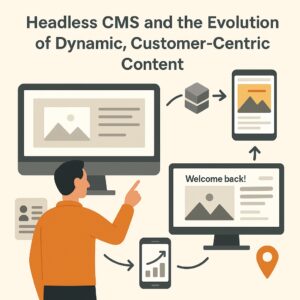Content marketing has changed. Gone are the days of static web pages and standardized blog posts. Now, personalized, real-time content experiences transform everything from a website visit to an in-store experience, based on each customer’s unique wants, needs, actions, and location. The Headless CMS is the key to achieving this brand-centric content across the board. With Headless architecture, organizations no longer need to rely on one-size-fits-all communication efforts but can drive adaptive, data-centric narratives that all rely on the customer experience being paramount.
From Publishing Static to Dynamic Experiences
In the digital marketing world of yesteryear, websites were static. If you wanted to change something, you had to code. If you launched additional pages, they would also be independent. As brands sought to scale across more web pages, conventional CMS solutions started to facilitate better publishing but still experienced limitations. Conventional content management systems operate on a single layer for both presentation and content management. They lack the ability to personalize or change in real-time easily.
The advent of the Headless CMS revolutionized the game because there is a severed bridge between the display and content layer and the possibility of serving up real-time, dynamic experiences in response to user interaction. Headless CMS for seamless marketing integration enhances this capability by connecting content, analytics, and automation tools to deliver cohesive, data-driven experiences across every channel. Instead of paginated content, brands can create living, breathing interactions that change at any moment based on what customers do in the moment, the devices they’re on, and how engaged they are.
The Rise of Customer-Centric Messaging
Customers have low tolerance for vague positioning and broad messaging. They want personalized content. If they engage with a brand at any touchpoint, they expect that brand to understand who they are and how they’ve come to interact offering messaging specific to their needs. Customer-centric content values every touchpoint and stage in the buyer journey from awareness through recovery or even advocacy.
A Headless CMS operates as the center of all customer-facing content. It connects easily with analytics tools, CRMs and personalization applications so that any time a customer touches an element of communication from a website and mobile app to email outreach they feel as if they’ve engaged with that entity before; it’s as if the brand not only knows who they are but also what they want.
The Benefits of Headless Architecture
Headless architecture is all about flexibility. Conventional CMS systems marry content to templates and assets that restrict where and how the messaging appears. A Headless CMS stores all content as structured data for easy access without connecting it to any styling or markup. Content can be pushed out through APIs to all channels with a decoupled approach facilitating dynamic distribution across websites, mobile applications, voice assistants, digital signage, and other devices that haven’t even hit the market yet.
For customers, this means cross-channel relevancy. If a brand publishes an update on a product in the Headless CMS, it can appear within seconds on multiple channels with personalization for whichever audience has their ear turned towards that medium. For marketers, this means control. They can create once and distribute everywhere without compromising quality or speed.
Structure Content for Dynamic Presentation
Structured content powers the Headless CMS. Instead of thinking of content as blocks of copy and graphics, structured content breaks elements down into reusable units (i.e. headlines, photos, descriptions, metadata) to be sourced in different orders and for different uses.
When information is modular, it’s more accessible for marketers to customize for varying locations and populations. For instance, a company might use the same structured information for a global campaign but allow the pieces to fall into place differently to create a marketing funnel in one area with images and language more specific to them. Structured content is scalable and precise by rendering every piece of marketing collateral dynamic and responsive along the customer journey.
Data Collaboration for Dynamic, Customer-Focused Content
Dynamic, customer-focused content relies upon data. A Headless CMS integrates effortlessly with analytics, CRMs, and customer data platforms (CDPs) to acquire information about behaviors, interests, and engagement patterns that dictate when and how content is provided.
For example, a clothing store can anticipate what its customers want based on where they’ve browsed online, recommend specific items when they’re next in-store, or tell them about a sale based on their previously purchased items. The beauty of a headless CMS and its API abilities is that it’s cloud-based; rapid changes occur immediately based on what the backend tracks. Intuition and intelligence back up dynamic content and customer-specific suggestions and offerings.
To Provide Omnichannel Consistency
More often than not, customers don’t engage with companies via one channel; they start the process on their laptops, continue it on a mobile app, and finish the checkout process through email. Companies must ensure these experiences are intertwined so as not to lose customers along the way.
A Headless CMS makes this cohesiveness possible. Because the dynamic accessibility always provides the same source of data, it secures that everything is coming from the same place. The intention behind an in-app ad will be identical to a blog post if it’s linked; from tone to design to execution, it will all be constant. Thus, organizations foster trust and affinity with their brands when they recognize consistency along the way.
Real-Time Personalization at Scale
Perhaps the ultimate customer experience deliverable of customer-centric marketing is personalization. A Headless CMS supports real-time personalization by harnessing content delivery and current data. Through APIs, it means that headlines, images, pitches or suggestions can change in real time based on audience/user/touchpoint action.
For example, if a visitor peruses winter jackets from a web browser, their mobile application could provide a feed populated with related items or their email could be triggered to showcase associated promotions. Such immediate reaction enables marketers to create one-to-one experiences from one-to-many all at once without manual processing or lag time within workflows.
Granting Marketer Control for Maximum Flexibility and Agility
One of the biggest advantages of a Headless CMS is flexibility for the marketer. No longer are teams bound by templates or systems that require heavy lifts for development; instead, in alignment with a singular control panel, content can be created, executed and edited with quickness and respect to aesthetics across channels.
This means that any time something must change whether for trend purposes or seasonal adjustments, or even a pivot in audience sentiment and intake marketers can act fast, and the data supporting the information delivery ensures that the subsequent systems respond instantly at every touchpoint. Whether it’s an event currently going on or a moment that’s trending, everyone in the moment can receive updated messaging across every channel powered by the Headless CMS. This keeps brands relevant, on their toes and aligned with customer-centric markers.
Real-Time Powered by APIs
APIs are what connect the separated systems. They are data aggregators and deliverers that function between the Headless architecture to ensure communication flow occurs without delay. Every time content is created or utilized at any brand touchpoint, an API sends it or collects it for real-time personalization.
No longer are campaigns static; they become living environments based on what’s happening in the moment. If someone is saving a cart or bookmarks, or even favoriting an item in a mobile application, an API may send something to the Headless CMS to say “someone just redeemed an offer” or “someone abandoned their cart,” ensuring that real-time dialog occurs at all levels. The Headless CMS becomes a disseminator and orchestrator of content as it makes sense throughout each individual customer journey to keep people engaged.
Personalization Without Sacrificing Brand Integrity
As brands become more agile, the risk of losing brand consistency increases. A Headless CMS not only has global oversight but local freedom as well. Headless CMS’ enable marketers to create rules for brand voice, imagery, messaging and more, allowing for versions of content to exist that can be personalized without straying too far from the brand standards established within the CMS.
Local teams use the same structure but can prioritize different aspects of the same message. For example, a campaign in New York may focus on speed and innovation; a similar one in Tokyo may focus on precision and quality but both adhere to the same design aesthetic and storytelling approach. When similar visuals create a consistent experience, personalization will never undermine authenticity.
Results That Matter to Marketers and Their Organizations
Dynamic, customer-driven content doesn’t mean much if it doesn’t drive measurable results. A Headless CMS interacts with analytics systems to monitor engagement, conversion rates, and success across channels. Marketers get real-time insights into what’s working and what’s not, as well as how versions perform relative to one another.
The immediacy of updates means that testing and optimization are seamless. Teams can run A/B tests, observe behaviors, and pivot on a dime to ensure maximum effectiveness. Marketing becomes a constant feedback loop for improvement, rewarding goal-oriented teams with actionable insights and contributions to tangible business objectives at the same time.
Future-Proofed Growth Oriented Through Headless CMS
Digital transformation is always changing. Augmented reality experiences, voice-activated assistants, and smart wearables are developing how audiences consume content and receive information as next-level channels. Future-proofing implementation is a breeze with a Headless CMS to allow brands to grow into these spaces without missing a beat.
Since Headless CMS architecture is API-first, there’s no need to build everything from scratch when new technologies come along. Content that exists in structure can easily transform formats so past and present can align seamlessly and innovation is prioritized over stability. For brands looking for sustainable growth, a Headless system is the only proper implementation.
H2: Dynamic, Consumer-Driven Marketing as an Offshoot of Creativity and Technology
Dynamic, consumer-driven marketing occurs when collaborative creativity and technological advancement foster it. The Headless CMS fills the void, supporting both sides with access to the best of both worlds resources for creatives to explore as much as possible and channels developers need and access to create what’s ideal for a universalized experience.
Thus, content needn’t sacrifice efficiency in favor of playfulness, innovation or even emotional draw. Marketers can focus on the background story and emotion behind it instead of how to present it since the Headless CMS will dynamically allow them to do so across channels. Developers can get their speed and scalability systems of choice in action without shifting focus away from creative pursuits. A Headless CMS is what keeps all modern-day marketing lives alive creativity and technology can be one seamless, dynamic entity with it at the forefront.
H2: Dynamic, Consumer-Driven Marketing as an Offshoot of Collaborative Benefit
Dynamic, consumer-driven marketing occurs when marketers, designers and developers collaborate to make resource availability worthwhile for all involved. The Headless CMS works as a centralized point of access where intradepartmental workers can use one source of structured content to understand what will work best for them across the developmental process.
Marketers have to understand how to personalize content creation for storytelling impact. Designers can contribute visual elements with a sense of brand equity. Developers require third-party systems and API access for feasible functions and usable opportunities. Everyone works in the same structured area, reducing redundancies, waiting periods to change and ineffective, intradepartmental communications that delay the speed-to-market goal at hand. Instead, by accessing the Headless CMS, these teams have all they need and the time required to provide input because they don’t struggle with previously dealt flaws; they’re engaged from the start with their piece for the greatest benefit.
Why work separately on an island when a Headless CMS can support such connected atmospheres? The second something goes live from one team, it’s developed at once and populated for all others so they gain benefit without needing to do more than has already been determined at that point in time. Everything exists for consumer-based interaction; thus, the Headless CMS embraces this mentality as part of collaborative advantage.
H2: Conclusion: The Future Belongs to Dynamic, Customer-Driven Content
But with consumers craving more substance and faster engagement, there’s no room for flat, one-dimensional marketing efforts. Enter the Headless CMS as the backbone of the shift to empower brands to engage and empower ever-changing, customer-focused content for every user, situation and medium possible.
With a blend of data structure, integration, and flexibility, the Headless architecture makes content come to life with ears to listen and a brain to learn and respond. This is not merely the next phase of digital marketing; this is the future of increasingly sophisticated, human-like brand interactions.








